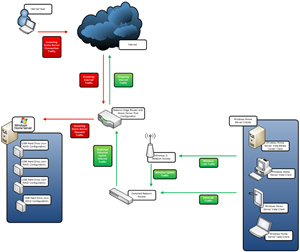One Man's eHome Vision
Software Architect Eric Charran had an eHome vision for his household. His goal was to access music, photos, videos, movies and TV shows (both live or recorded) from any TV or computer in the house and stop relying on physical media. For example, he no longer had to walk upstairs to get a DVD that he was watching in the bedroom to bring downstairs. Because its on shared hard disk storage, he can now access it from any media center (or extender) in the house.
He also wanted his eHome to have the spousal acceptance factor. It had to operate easily, intuitively and efficiently and his setup would also need a safety net using cloud concepts where critical data would be backed up “in the cloud”.
Using a copy of Windows Home Server, the KeepVault online backup add-in and copies of Vista SP1 Charran’s eHome is now complete.
The full story including details on how to make a DVD Library available from any computer are available in the post Architecture of the Charran eHome.
Share this WHS Article with Others:





Nice article, really. I have set my home up similarly way back in the WHS Beta days, except I don’t use Media Center at all (but may shorty). Instead I use First Gen Xboxes with the XBMC soft mod to access all my movies, pictures and music on all the TV’s and stereos in the home. I’ve found no need to record TV shows beyond what my cable DVR supplies, hence the lack of WMC machines, though web surfing via the big screen would be sweet.
Also, I use WHS as a central storage unit that all machines access files from. No files are saved locally to each pc.
Use of the Cloud as a backup was integrated by me using Handy Backup and send WHS files to my off shore web and storage server hosted elsewhere. See my How To on that here on MS Windows Home Server blog.
Anyway, very good way to use WHS. Have fun.
Last night, I did something stupid on my primary desktop computer (a Vista box) and needed to restore the system to a recent backup. I use Windows Home Server on my home network, so I was confident in my ability to roll back the system to a previous night’s backup. I booted my machine using the WHS Client Restore CD, chose the appropriate backup, waited (im)patiently for about two hours while the bits were restored, the system rebooted…
…and that’s when I saw the Blue Screen of Death… specifically, a STOP 0x0000C1F5.
Additional details here:
http://www.delmartian.com/TheGalacticToilet/CategoryView,category,WHS.aspx
I am experiencing the same boot problem (Stop 0x0000c1f5) on WHS after a Vista automatic update.
The Microsoft Solution:
“If you have multiple disks installed, and the disk on which the $TxfLog file is corrupted does not contain Windows Vista, remove the offending disk from the computer.” – Microsoft
Microsoft KB 946084 Posted Article:
http://www.support.microsoft.com/kb/946084
I’ve heard many people moan that WHS doesn’t include a shared calendar, Exchange, Active Directory, etc.
However, WHS forces users to use UNC names, instead of drive letters. In addition, Remote access allows you to access all your stuff on your WHS through a web interface, which sucks. Really. It is slow, and it’s also cumbersome. There’s much room for improvement there, and with improvement i mean “rewrite”.
You can also use your WHS as a RDP gateway to access your machines at home through RDP, which seems intelligent until you realise that XP Home, Vista Home Basic and Vista Home Premium don’t ship with RDP.
It is not meant to be used by IT professionals at home! WHS is an appliance, not a complete server solution.
No mirroring your collection of legal DVD backup files too!
@IT Technician –
Shared calendar, Exchange, Active Directory? Aaron is correct – Are you kidding? WHO is saying this? I have not heard anyone complain about missing these things on WHS.
MS Exchange is a separate product, not built-in service that comes along with a Windows server. A “shared calendar” – well, I don’t even think you even know *what* that is, let alone if it is either a separate product or a server component. I can get a “shared calendar” using MS Windows Calendar that comes FREE with Vista (or Outlook Express on XP), or use Google Calendar.
Real IT network techs actually use UNC names, understand them and prefer them. Drive letters are for end-users for things like a “home drive”. WHS makes it easy by providing a direct shortcut to the UNC shared folders on the server. UNC names specifically designate the server name, so it is guarenteed to work and simple to see if it is wrong. Drive letters require translation by the server to – guess what – a UNC name. What do you know about that?! Even UNIX works the same way – translating a mapped drive letter to a fully-qualified path.
But then again, as your name suggests, you are an *IT Technician*. You would know all of these provable facts…….right?
Yeah……right.